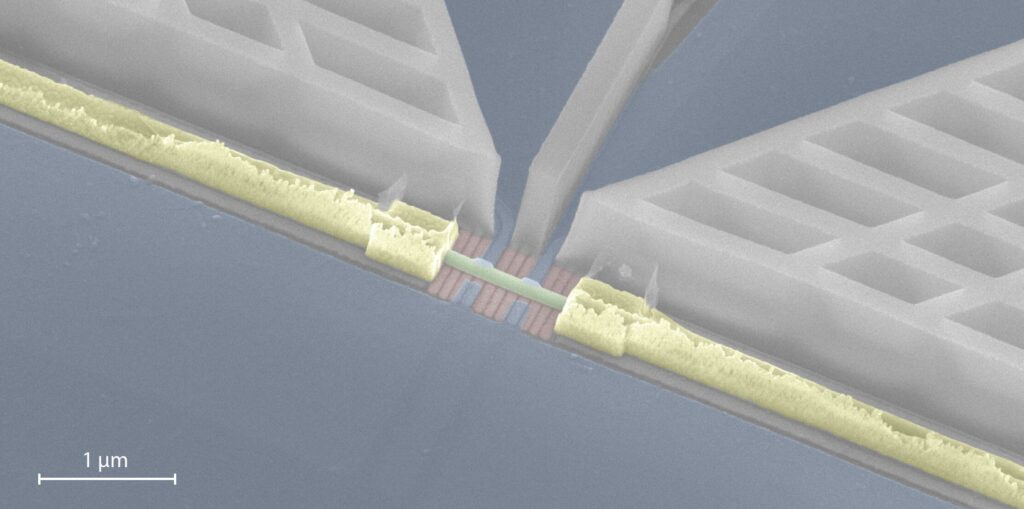An international research team led by QuTech has realized a three-site Kitaev chain using semiconducting quantum dots coupled by superconducting segments in a hybrid InSb/Al nanowire. When comparing two-and three-site chains within the same device, they observed that extending the chain to three sites increased the stability of the zero-energy modes. This work demonstrates the scalability of quantum-dot-based Kitaev chains and their potential to host stable Majorana zero modes. The researchers published their results in Nature Nanotechnology.
Majorana zero modes (MZMs) are quasiparticles predicted to occur at the edges of topological superconductors. In addition, MZMs are anticipated to display non-Abelian exchange statistics—a key feature for topological quantum computation—making topological superconductors a promising candidate for decoherence-free quantum computing and high-fidelity quantum gates.
A one-dimensional topological superconductor can be created with the Kitaev model—a chain of spinless fermions coupled via p-wave superconductivity and electron hopping—which becomes topological for longer chains. Now, researchers have realized a three-site Kitaev chain and demonstrated an enhanced stability for the zero-energy modes in comparison to two-site chains.
Scaling up Kitaev chains from two to three sites
Over the last decade, researchers have developed multiple experimental platforms as potential realizations of topological superconductivity. Recently, a new approach was realized: a minimal Kitaev chain consisting of two quantum dots coupled through a superconductor (as recently created by QuTech).
Even this short two-site Kitaev chain proved to host a pair of MZMs, though they had a low stability, earning them the name poor man’s MZMs. As MZMs in longer chains are predicted to be unaffected by local noise and chemical potential variations, researchers aim to scale up the two-site chain to additional sites.
For this study, researchers led by Leo Kouwenhoven and Grzegorz Mazur and first authors Alberto Bordin and Chun-Xiao Liu from QuTech, with materials supplied by the group of Erik Bakkers at the Technical University Eindhoven, developed a three-site Kitaev chain. The chain is made of three semiconducting quantum dots connected via superconducting segments in a hybrid InSb/Al nanowire.

Mazur explains, “Building on previous work, we scaled up our two-site Kitaev chain to three sites and discovered that Majorana zero modes are more stable on this new platform. This work demonstrates that scaling up Kitaev chains to many more sites is a promising approach to obtain stable Majorana zero modes.”
Bordin adds, “We previously showed that even a minimal two-site Kitaev chain can host Majorana bound states. However, these were unprotected. Having now identified that their stability increases once we lengthen the chain demonstrates that this strategy is useful for technological applications. From our calculations, it seems that five or six sites would be enough to devise a technology that can outperform other approaches.”
Bringing all the pieces together
This work is part of a larger effort that started three years ago at QuTech. Mazur says, “At first, we managed to create a unit cell which coupled two quantum dots through superconducting pairing. Though this unit cell was not yet a topological superconductor, it did host two MZMs at its edges. In order to now get to a topological regime, we needed to stack multiple unit cells together. We therefore had to learn and establish a firm foundation on how to couple these individual elements together.”
To scale up the device, the researchers combined the work laid out in their previous publications: a first publication demonstrating triplet Cooper pair splitting—an essential ingredient of the Kitaev chain Hamiltonian, a second one demonstrating the fabrication of the two-side Kitaev chain, and a third explaining how to tune this system.
“We brought all these pieces together with increased precision to create a functional system with larger dimensions,” Bordin explains.
Fabrication of the device—which hosts eleven gates—proved time-consuming. After multiple iterations in the cleanroom, Bordin and his colleagues managed to create multiple working devices. Measurements showed that all measured devices hosted three-site chains displaying robustness against perturbations.
Mazur says, “I was astonished by the reproducibility of the measurements. When I found out that the final results on both devices looked nearly identical, I ran around in the lab telling my colleagues that we had created two different devices with identical spectra.”

Lengthening the chain
As a next step, the researchers will subject their device to quantum information experiments. “We want to investigate how these Kitaev chains behave as a qubit,” Mazur explains.
“It will be very interesting to see how the length of the Kitaev chain influences the lifetime of the qubit. Two-site chains display low stability and qubits will therefore be limited by electrical noise on the gate voltages. For a three-site chain however, we have now demonstrated that zero modes are more stable. Tuning a qubit using these longer chains should be less affected by gate noise.”
To achieve true topological protection, Bordin aims to make the Kitaev chains even longer: “Employing machine learning to automatically tune these Kitaev chains could help obtain topological protection.” Once properly scaled up in the future, the work could lead to a first practical quantum computing technique.
Mazur says, “Step by step, we are building our way to a topological qubit.”
Kouwenhoven adds, “We are continuously making progress: a new work on three-site Kitaev chains coupled to an additional quantum dot is already in the pipeline and should appear online in a few weeks.”


